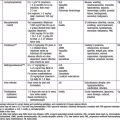Chapter 329 Eosinophilic Gastroenteritis
Heine RG. Pathophysiology, diagnosis and treatment of food protein induced gastrointestinal disease. Curr Opin Allergy Clin Immunol. 2004;4:221.
Ngo P, Furuta G, Burks W. The pathobiology of eosinophilic gastroenteritis of childhood: is it really the eosinophil, allergic mediated, or something else? Curr Gastroenterol Rep. 2004;6:436-440.
Rothenberg ME. Eosinophilic gastrointestinal disorders (EGID). J Allergy Clin Immunol. 2004;113:11-28.




